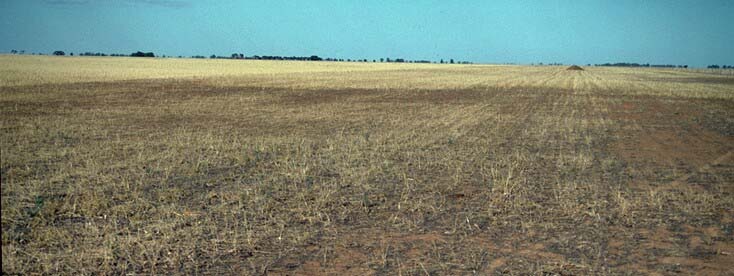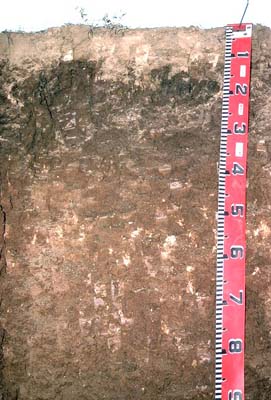LP56
| Property: LP56 Wanurp | Group: Pine Grove Farm Advance |
| Australian Soil Classification: Calcic, Mesonatric, Red SODOSOL | Northcote Factual Key: Dr 2.1 |
| Great Soil Group: red-brown earth | Geology: Quaternary (Shepparton Formation) alluvial and aeolian deposits. |
| General Landscape Description: General Landscape Description: Old alluvial plain (slightly rising) which was relatively treeless in its original state. This site occurs in a slight depression. | |
 LP56 Landscape |
Soil Profile Morphology
Surface Soil
| A1 | 0-10 cm | Dark brown (7.5YR4/4); fine sandy clay loam; hardsetting surface condition; massive; strong consistence moist; pH 6.5; sharp change to: |  LP56 Profile |
| Subsoil | |||
| B21 | 10-40 cm | Dark reddish brown (5YR3/4); medium heavy clay; strong coarse blocky structure; strong consistence dry; pH 8.1; gradual change to: | |
| B22k | 40-110 cm | Strong brown (7.5YR5/6); medium heavy clay; strong to medium coarse polyhedral structure; firm consistence dry; contains a few (5-10%) fine-earth carbonates and very few (1%) hard calcareous nodules; pH 8.9; gradual change to: | |
| B23k | 110 cm+ | Strong brown (7.5YR5/6) and yellowish red; light clay; strong fine to medium polyhedral structure; firm consistence dry; contains many (25%) carbonates (15% fine-earth and 10% hard nodules); pH 9.0. |
Key Profile Features
- Strong texture contrast between surface (A) horizon (clay content 29%) and subsoil (B21) horizon (clay content 67%).
- Hardsetting surface soil, with a high fine sand (39%) and silt (28%) content.
Key Profile Characteristics
pH | Salinity Rating | |||
Surface (A1 horizon) | slightly acid | low | sodic | slight1 |
Subsoil (B21 horizon) | moderately alkaline | low | strongly sodic | complete |
Deeper subsoil (at 1 m) | strongly alkaline | medium-high | strongly sodic | none2 |
| 1 Complete dispersion after remoulding. 2 Lack of dispersion due to high level of soluble salts. | ||||
 |
Horizon | Horizon Depth | pH (water) | EC 1:5 | NaCl | Exchangeable Cations | |||
Ca | Mg | K | Na | |||||
meq/100g | ||||||||
A1 | 0-10 | 6.5 | 0.16 | 3.5 | 2.8 | 0.7 | 0.6 | |
B21 | 10-40 | 8.1 | 0.26 | 0.06 | 7.2 | 7.9 | 1.7 | 3.8 |
B22k | 40-110 | 8.9 | 1.28 | 0.21 | 5.2 | 8.7 | 1.2 | 6.9 |
B23k | 110+ | 9 | 1.08 | 0.21 | 4.4 | 7.8 | 0.9 | 5.7 |
Horizon | Horizon Depth | Ex Al mg/kg | Ex Ac meq/100g | Field pF2.5 | Wilting Point pF4.2 | Coarse Sand (0.2-2.0mm) | Fine Sand (0.02-0.2mm) | Silt (0.002-0.02mm) | Clay (<0.002mm) |
A1 | 0-10 | 23.9 | 8.8 | 6 | 39 | 28 | 29 | ||
B21 | 10-40 | 38.2 | 21.6 | 2 | 18 | 15 | 67 | ||
B22k | 40-110 | ||||||||
B23k | 110+ |
Management Considerations:
- In general, management strategies for all soils should aim to increase organic matter levels in the surface soil; minimise the degradation of soil aggregates and porosity; promote the development of stable biopores; improve the calcium status of the ion exchange complex (particularly when sodium is a significant part – i.e. sodic), and break up any hardpans. Less frequent tillage; using less aggressive implements, and working the soil at optimum moisture conditions can all assist in maintaining soil aggregation and porosity as well as reducing the breakdown of organic matter. Practices such as residue retention, minimum tillage and including pasture rotations could be utilised if cropping takes place in order to build up organic matter, reduce erosion risk and increase fertility.
- Plant available water capacity (PAWC) is estimated to be low (estimated at 80 mm) for this profile-based on available laboratory data. Effective rooting depth will be limited by the strongly sodic subsoil.
Surface (A) Horizons
- The surface soil has a low overall nutrient status (based on the sum of the exchangeable basic cations).
- The surface horizon is hardsetting when dry and has a high fine sand (39%) and silt (28%) content. When cultivated dry the soil will become “powdery” and the structure will breakdown. Tillage should be minimised and stubble retention/pasture rotation practised to build up organic matter levels.
- Surface horizon is sodic and disperses slightly. After remoulding it disperses completely which suggests that excessive cultivation or over stocking of the soil in a wet condition may result in the development of surface crusting and exacerbate the hardsetting condition. Gypsum is usually an effective ameliorant on such soils.
- Organic carbon levels are low for the surface soil. Improving organic matter levels will assist in minimising structural problems such as surface sealing and dispersion as well as improving soil fertility and water holding capacity.
Subsoil (B) Horizons
- The coarsely structured upper subsoil is strongly sodic and disperses completely in water. This is likely to result in water and root movement being restricted.
- Salinity rating becomes medium to high at 40 cm depth. This may restrict the growth of salt sensitive species (e.g. maize and many legumes).
Comments from Landholder
- Relatively poor cropping soil (compared to site LP55).


